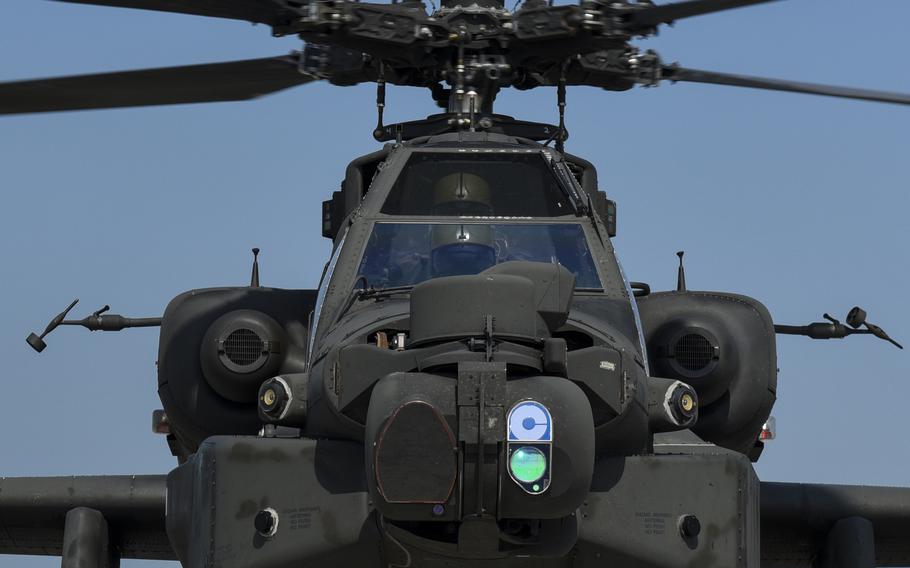
A U.S. Army AH-64 Apache helicopter waits to refuel at Kunsan Air Base, South Korea, Aug. 7, 2017. (Michael Hunsaker/U.S. Air Force)
South Korea is canceling its planned purchase of 36 AH-64E Apache helicopters from the United States and redirecting some of the money to unmanned systems, according to a South Korean lawmaker.
The South’s Joint Chiefs of Staff decided in May to scrap the acquisition, which would have doubled the South Korean army’s fleet of Apache attack helicopters, Rep. Yoo Yong-won wrote in a Facebook post Sunday. He said the government chose instead to invest in other military projects, such as drones.
The initial budget allocation of $7.2 million for administrative fees related to the helicopter purchase was reduced to $220,000, Yoo said. That amount was later eliminated entirely, a Yoo spokesperson told Stars and Stripes by phone Tuesday. It’s customary in South Korea that some government officials speak to the press on condition of anonymity.
The total estimated cost of the proposed purchase — which included gunships, rocket launchers, air-to-ground missiles, technical support and other features — was approximately $3.5 billion, according to an Aug. 19 news release from the U.S. Defense Security Cooperation Agency. The primary U.S. contractors were Boeing and Lockheed Martin.
“This is a competition for a limited budget,” Yang Uk, a research fellow at the Seoul-based Asan Institute for Policy Studies, said by phone Tuesday.
While drones are playing a growing role on the battlefield, helicopter gunships remain essential, Yang added.
“One of the biggest strengths for Apache is that it allows us to detect the targets from long distances with the Longbow radar and overlook the operation,” he said. “There are clear advantages such as the Blue Force Tracker, which lets us coordinate with the allies within the area and avoid damage.”
The price of a new Apache prior to negotiations was around $56 million, about 66% more expensive than those in the first batch of 36 gunships delivered to the army in 2017, Minister of Defense Acquisition Program Administration Seok Jong Gun said during a televised National Assembly hearing on Oct. 15.
The increase, Seok said, was due to inflation and technological upgrades, including Longbow — an advanced fire control radar system that allows crews to quickly identify targets.
North Korea’s state-run media criticized the proposed sale in August, calling it a “reckless” act that threatened peace on the Korean Peninsula.
South Korea’s decision comes two months after Defense Secretary Pete Hegseth ordered the U.S. military to “reduce and restructure manned attack helicopter formations” in lieu of cheaper “drone swarms capable of overwhelming adversaries,” according to an April 30 Pentagon memo to the Army secretary.
The restructuring is part of broader efforts to cut “wasteful spending” and modernize the military, the memo said.
South Korea has increasingly focused on countering drone threats following the incursion of five North Korean unmanned aerial vehicles into its airspace on Dec. 26, 2022. One drone came within two miles of the presidential office in Seoul, though none were intercepted.
In response, South Korea launched its Drone Operations Command in September 2023, based in Pocheon, about 21 miles south of the Demilitarized Zone.